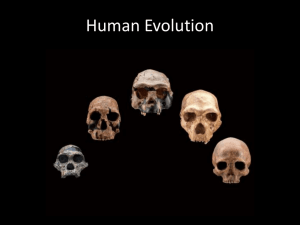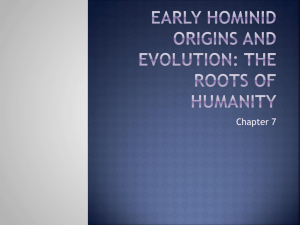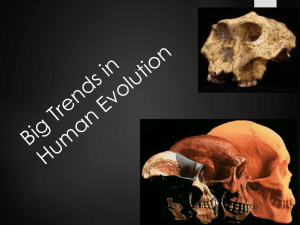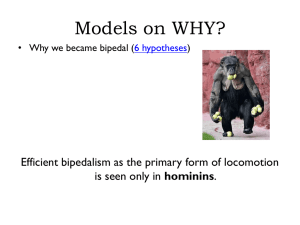Origins of Humanity
advertisement
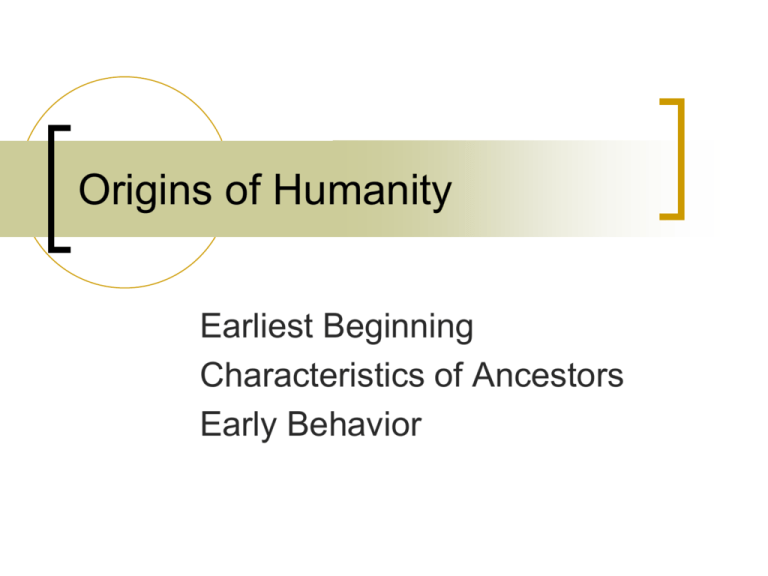
Origins of Humanity Earliest Beginning Characteristics of Ancestors Early Behavior Earliest Beginnings Ca. 25-5 million years ago (mya) Miocene primates Ca. 6-2 mya Hominids, early culture Miocene Primate Evolution The Miocene epoch (25-5 mya) "The Golden Age of Apes" Two major hominoid radiations The dryopiths - Early to Middle Miocene (25-15 mya) The ramapiths - Middle to Late Miocene (15-5 mya) Dryopithecus Ramapiths (Sivapithecus) Gigantopithecus Gigantopithecus is known to have lived in what is now China and Southeast Asia. Gigantopithecus was the largest primate that ever walked the Earth. He would have risen 9 to 10 feet high if he choose to stand up on only his hind legs, and probably weighed about 600 lbs (a mountain gorilla male weigh about 400 lbs). Some suggest that Gigantopithecus is not extinct, but is hiding in remote areas of the Himalaya Mountains or the forests of North-West America. Could a Gigantopithecus, or his descendants, be the source of the Yeti or Bigfoot tales? http://www.unmuseum.org/bigape.htm Size Differences http://www.unmuseum.org/bigape.htm Our Last Common Ancestor? Unable to determine exact specimen as yet (Dryopith or Ramapith) Molecular data suggests split occurred between 6 and 5 million years ago. Extensive genetic diversity in hominoids during the Miocene makes things complicated. Scientific Evidence Earliest humans (hominids) Evolved 5-6 million years ago in Africa Very similar to apes, but: Characteristics Bipedal Small brain size Relatively small body size Between 3 and 4 feet 60-100 pounds Bipedality Evidence Anatomy of Bipedalism Early hominid pelvis on left, modern human on right. Comparisons Basal Hominids (6-4 mya) Sahelanthropus tchadensis Ardipithecus ramidus Australopithecus anamensis Orrorin tugenensis Recent specimens that date to this time period may represent the earliest on the human line, but not a lot of data yet. Most have small brains and were probably bipedal. What did they look like? tchadensis tugenensis anamensis Australopithecines Australopithecus afarensis Australopithecus africanus Australopithecus garhi Australopithecus afarensis (ca. 3.5mya) Australopithecus afarensis “Lucy” Discovered by Donald Johanson and Tom Gray in 1974 at Hadar in Ethiopia (Johanson and Edey 1981; Johanson and Taieb 1976). Its age is about 3.2 million years. Lucy was an adult female of about 25 years. About 40% of her skeleton was found, and her pelvis, femur (the upper leg bone) and tibia show her to have been bipedal. She was about 107 cm (3'6") tall (small for her species) and about 28 kg (62 lbs) in weight. Other Evidence: Laetoli footprints • • In 1976, members of a team led by Mary Leakey discovered the fossilized footprints of human ancestors in Laetoli, Africa. The footprints were formed 3.5 million years ago when at least two individuals walked over wet volcanic ash. The wet ash hardened like cement and was then covered by more ash. Laeotoli Some analysts have noted that the smaller of the two clearest trails bears telltale signs that suggest whoever left the prints was burdened on one side -- perhaps a female carrying an infant on her hip. The detailed interpretation of the prints remains a matter of debate, they remain an extraordinary and fascinating fossil find, preserving a moment in prehistoric time. Laetoli Paleoecological reconstructions for that time include bushland and aquatic fauna at Laetoli and closed woodland at Hadar. Direct evidence of bipedality in Australopithecus anamensis dates from between about 3.9 and 4.2 mya (Leakey, et. al. 1995). http://www.pbs.org/wgbh/evolution/library/07/1/l_071_03.html http://www.jqjacobs.net/anthro/paleo/bipedalism.html Why Bipedal? Three key features differentiate human and chimpanzee bipedalism: Chimpanzees are unable to extend their kneejoints to produce a straight leg in the stance phase. Muscular power has to be exerted to support the body. The constantly flexed position of the chimpanzee leg also mean there is no toe off and heel strike in the swing phase. http://www.stanford.edu/~harryg/protected/chp15.htm Advantages of Bipedalism? With its radically different anatomy, bipedalism clearly was an adaptation to terrestrial living, but was it an advantage over quadrapedalism? Not necessarily faster, but likely sustainable over long distances Protection from predators? Latest evidence for earliest hominids puts them in forested environment, not open habitat Did free hands for tool-using, but what tools; or possibly food transport? Theories The postural feeding hypothesis (Hunt 1996) is an ecological model. The behavioral model (Lovejoy 1981) attributes bipedality to the social, sexual and reproductive conduct of early hominids. The thermoregulatory model (Wheeler 1991) views the increased heat loss, increased cooling, reduced heat gain and reduced water requirements conferred by a bipedal stance in a hot, tropical climate as the selective pressure leading to bipedalism. http://www.jqjacobs.net/anthro/paleo/bipedalism.html Hunt's postural feeding hypothesis Hunt's postural feeding hypothesis asserts that the arboreal food gathering postures of arm-hanging and vertical climbing, a shared adaptation and postural specialization of apes, are sufficiently common to influence anatomy. Both chimpanzee behavior and australopithecine anatomy inform the model. Eighty percent of chimpanzee bipedalism is during feeding with arm-hanging stabilizing the posture 93% of the time in terminal branches and 52% in the central parts of trees. Torso form in australopithecines features adaptations to armhanging, inferring australopithecine adaptation to arboreal bipedal fruit gathering. According to Hunt, this early and specialized origin of bipedalism only later evolved into habitual bipedal locomotion. http://www.jqjacobs.net/anthro/paleo/bipedalism.html The behavioral model The behavioral model, as presented by Lovejoy, focuses on social behavioral mechanisms that influence survivorship and birthrate. Human sexual behavior and anatomy are hypothesized as implying a monogamous mating structure, a social form seen as prerequisite to male provisioning. Provisioning behavior with the upper limbs used to transport food to a mate and offspring is seen as a strong selection factor for bipedality by directly improving offspring survivorship and increasing reproductive rate. http://www.jqjacobs.net/anthro/paleo/bipedalism.html Wheeler's thermoregulatory model Wheeler's thermoregulatory model proposes, as the selective pressure, bipedalism conferring reduction in heat gain and facilitation of heat dissipation. Bipedalism raises the mean body surface higher above the ground, where more favorable wind speeds and temperatures prevail. Greater wind flow translates to higher convective heat loss. Bipedalism reduces evaporative cooling requirements and conserves body water. Vertical orientation also minimizes direct solar exposure during the time of day when the solar radiation is most intense. http://www.jqjacobs.net/anthro/paleo/bipedalism.html Do we really know? Timing The timing of the appearance of bipedalism is of critical importance in assessing these competing hypothesis. The models all present plausible selective pressures needed for evolutionary change: food access, provisioning, survivorship assurance, increase in offspring, predator and injury avoidance and energy and water conservation. Under different conditions the individual importance of these pressures will change. The important question is what conditions prevailed at the time that bipedalism appears in the fossil record. http://www.jqjacobs.net/anthro/paleo/bipedalism.html Paleoenvironment Vrba's "turn-over pulse" hypothesis supports a major climate change, with onset of drier conditions and diminution of wooded habitats, beginning in the Pliocene around 2.5 mya. Habitat reconstruction based on faunal associations with hominid fossils demonstrate that Australopithecus species lived in wooded and well watered environments (Reed 1997). Homo is the first hominid known to have adapted to open, savannah-like habitats, well after the evolution of bipedality. http://www.jqjacobs.net/anthro/paleo/bipedalism.html Which is it? Thus, from an paleoecological perspective, the thermoregulatory model does not fit the evidence. With the behavioral model, which hypothesizes monogamous pair bonding and reduction in mate competition as changing social factors antecedent to bipedalism, one would expect an earlier reduction in canine size, in parallel with the evolution of bipedalism. Arm-hanging anatomy persists long after the onset of bipedal characteristics, indicating occupation of wooded niches for the early bipedal hominids, so Hunt’s feeding model might be most appropriate. http://www.jqjacobs.net/anthro/paleo/bipedalism.html Australopithecus africanus (ca. 3 mya) South Africa was the home to the species Australopithecus africanus, which lived 3.3 to 2.5 million years ago. This species was the first of the australopiths to be described; Raymond Dart named the genus and species in 1925 after his discovery of the famous Taung child. Many features of the cranium of A. africanus are more evolved than that of earlier A. afarensis. These features include a more globular cranium and slightly higher ratio of brain size to body size. Also the teeth and face appear less primitive. http://www.mnh.si.edu/anthro/humanorigins/ha/afri.html A. africanus For years researchers considered the evolution of early humans to pass from A. afarensis to A. africanus and lead to early Homo. However, some researchers now believe that facial features link A. africanus to the "robust" early human species of southern Africa, Paranthropus robustus http://www.mnh.si.edu/anthro/humanorigins/ha/afri.html Australopithecus garhi A. garhi existed 2.5 million years ago. Tim White and Berhame Asfaw found it in Bouri, East Ethiopia. Characteristics: cranial capacity of 450ml. canines and premolars like Homo genus huge molars no diastema prognathic ape-like arms and legs The importance of this hominid is that it was found with many tools and an array of slaughtered animals. Tool use has been the defining criteria that separated the Homo genus from the Australopithecines. http://www.humboldt.edu/~mrc1/main.shtml Genus Paranthropus Robust Early Hominids (2.5-1.5 mya) Extinct branch/lineage Highly specialized features Heavy brows Large teeth, particularly back Large muscle attachment areas Paranthropus robustus DNH 7, "Eurydice", Paranthropus robustus. Discovered by André Keyser in 1994 at the Drimolen cave in South Africa. Estimated age is between 1.5 and 2.0 million years. Paranthropus boisei OH 5, "Zinjanthropus", "Nutcracker Man", Paranthropus boisei Discovered by Mary Leakey in 1959 at Olduvai Gorge in Tanzania (Leakey 1959). Estimated age is 1.8 million years. Paranthropus aethiopicus By 2.7 million years ago, a new lineage of early humans had evolved in East Africa: Paranthropus aethiopicus http://www.mnh.si.edu/anthro/humanorigins/ha/a_tree.html

